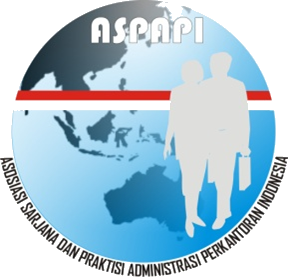Development of Career Patterns of Civil Servants in the Human Resources Staff Unit of the National Police
(1) Politeknik STIA LAN Jakarta
(2) Politeknik STIA LAN Jakarta
(3) Politeknik STIA LAN Jakarta
(*) Corresponding Author
DOI: https://doi.org/10.26858/ja.v10i1.45416
Abstract
The existence of civil servants in the National Police institution is something unique and distinctive because in the National Police organization, the position of civil servants is in one organization with the National Police in all units of the National Police in charge of carrying out administrative activities and tasks that require special expertise to support the activities of the National Police. For civil servants of the National Police, personnel regulations apply to the National Police and personnel regulations regulated by BKN. The purpose of this study is to analyze the causes of the lack of optimal implementation of career patterns for civil servants in the Human Resources Staff (SSDM) of the National Police and provide a description related to career pattern models that are more professional and appropriate for civil servants in SSDM Polri which can be used as a career pattern model for National Police Civil Servants. This research uses a mix method approach, quantitative data collection which is then deepened qualitatively through interviews, observations and collection of supporting documents. The result is that the career pattern of civil servants in the Human Resources Staff Work Unit is constrained by human resource management governance in the aspects of planning, organizing, procuring and directing, developing and integrating. A more provective career pattern model obtained from the results of discussion and analysis in this study is the placement of civil servants in predetermined functional and structural positions, the implementation of internships for employees who newly recruited, implementation of performance evaluation for promotion followed by attending education and training in accordance with the field of work, providing space and opportunities to actualize themselves to the duties and responsibilities that given in order to be promoted to the top posotion intended for civil servant after attending a series of education and training for competency development.
Full Text:
PDFReferences
Bagian Perencanaan dan Administrasi Staf Sumber Daya Manusia, P. (2021). Proporsi jumlah Personel Polri dan PNS .
Bambacas, M., & Bordia, P. (2009). Predicting different commitment components: The relative effects of how career development HRM practices are perceived. Journal of Management and Organization, 15(2). https://doi.org/10.5172/jmo.837.15.2.224
Blustein, D. L., Erby, W., Meerkins, T., Soldz, I., & Ezema, G. N. (2022). A Critical Exploration of Assumptions Underlying STEM Career Development. Journal of Career Development, 49(2). https://doi.org/10.1177/0894845320974449
Darwis, M., Arhas, S. H., & Prasodjo, T. (2022). Work Stress on Employees of Perum BULOG Bulukumba Branch. Journal of Public Administration and Government, 4(2), 243–250.
Hernaus, T., Pavlovic, D., & Klindzic, M. (2019). Organizational career management practices: The role of the relationship between HRM and trade unions. Employee Relations, 41(1). https://doi.org/10.1108/ER-02-2018-0035
Ivanchevich J M. (2010). Human resource management. In Surface Mining (Eleven). Irwin.
Jena, L., & Nayak, U. (2020). Theories of Career Development: An analysis. Indian Journal of Natural Sciences, 10(60).
Kettunen, J. (2021). Career experts’ conceptions of innovation in career development. International Journal for Educational and Vocational Guidance. https://doi.org/10.1007/s10775-021-09509-9
Loyarte-López, E., García-Olaizola, I., Posada, J., Azúa, I., & Flórez, J. (2020). Sustainable career development for R&D professionals: Applying a career development system in Basque country. International Journal of Innovation Studies, 4(2). https://doi.org/10.1016/j.ijis.2020.03.002
Malik, A., Ali, M. A., Rafiq, S., & Adnan, M. (2022). Employee Perception, Barriers towards Career Development and HRM Strategies tenacity Employee Career Development. Sustainable Business and Society in Emerging Economies, 4(2). https://doi.org/10.26710/sbsee.v4i2.2415
Mok, I., Mackenzie, L., & Thomson, K. (2021). Career development and human resource management of older workers: A scoping review. Australian Journal of Career Development, 30(3). https://doi.org/10.1177/10384162211069208
Niswaty, R., Basit, M. A., Nur, A. C., & Arhas, S. H. (2023). Effect of Application of E-Kinerja Assessment System in Improving Employee Performance. KnE Social Sciences, 1–9.
Niswaty, R., Dhahri, I., Nasaruddin, H., & Arhas, S. H. (2021). Organizational Culture and Employee Performance. International Joined Conference on Social Science (ICSS 2021), 652–656.
Peraturan Kapolri Nomor 16 Tahun 2017 Tentang Pola Karier Pegawai Negeri Sipil Di Lingkungan Polri, (2017).
Pradhan, G. M. (2020). Impact of Human Resource Management Practices on Behavioural Outcomes of Financial Institutions of Nepal. The Batuk, 6(1). https://doi.org/10.3126/batuk.v6i1.32632
Robbins, S. P., & Coulter, M. (2010). Manajemen (Edisi Kesepuluh). Erlangga.
Sudharshini, C., & Rajakrishnan, V. S. (2019). The effect of promotion and career development of organizational HRM practices on employee absenteeism. Journal of Interdisciplinary Cycle Research, XI.
Sulbout, J., Pichault, F., Jemine, G., & Naedenoen, F. (2022). Are skilled contingent workers neglected? Evidence from a cross-sector multiple case study on organizational career management practices. European Management Journal, 40(3). https://doi.org/10.1016/j.emj.2021.07.005
Suprianto, S., & Arhas, S. H. (2022). Quality of Employee Performance at the Makassar City Ujung Tanah Sub-District Office. PINISI Discretion Review, 5(2), 353–360.
Zacher, H., Rudolph, C. W., Todorovic, T., & Ammann, D. (2019). Academic career development: A review and research agenda. In Journal of Vocational Behavior (Vol. 110). https://doi.org/10.1016/j.jvb.2018.08.006
Article Metrics
Abstract view : 104 times | PDF view : 16 timesRefbacks
- There are currently no refbacks.
Copyright (c) 2023 Syaifuddin Syaifuddin, Nurliah Nurdin, Mala Sondang Silitonga

This work is licensed under a Creative Commons Attribution 4.0 International License.






























 under a
under a